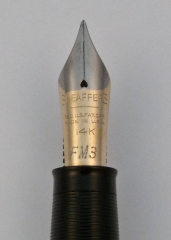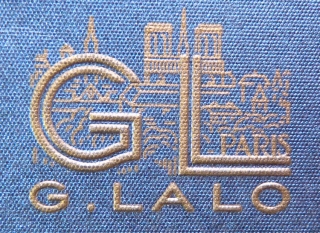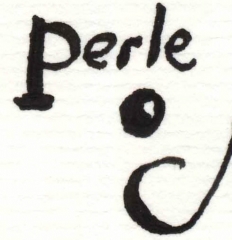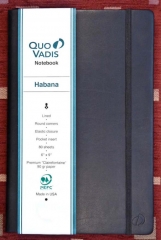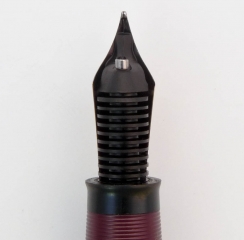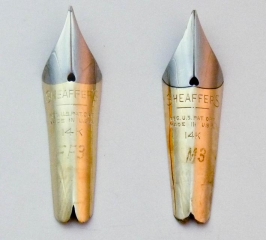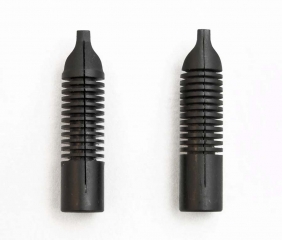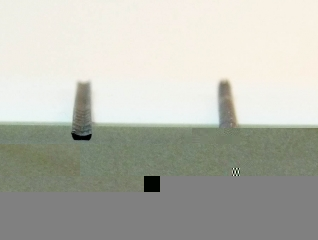The idea that effort can be saved by gathering tasks together to tackle as a single unit is not something that originated with me. Being both lazy and a procrastinator I find myself afloat in a sea of topics and items I wanted to write about but never got around to. Thus I’m applying that principle here in this stitched together post that I hope will intertwine some ink, paper, and pen items sitting around here.
Pen
I single-mindedly comb the world for Sheaffer Snorkels with interesting nibs. My day races by with me obsessively hunched over a monitor, a phone in my hand, utilizing a chip in my cerebral cortex that gives me a direct uplink to the Internet. OK, most of that isn’t true but I do look more often than the average person to see if I can find something cool.
A little while ago I got lucky and found myself a pretty good deal on a Sheaffer Snorkel with a traditional open nib. Not a run-of-the-mill example this had the FM3 marked nib (medium point flexible). These are hard to find (proverbial hens teeth, needle in a haystack, or bit of food a pug won’t eat rare) and when I was the happy owner the bill came to an astounding $22. Lucky? No…it was skill! OK, I got lucky. I thought I was the Baron of Penfindia until a friend found something similar for $11. Descent from smugness is sometimes so rapid you skin your knees.
What is odd is that this nib has less flex and a slightly narrower line than the other FM3 nib I have. It’s still flexible but not as giving as the predecessor nib in my collection. I have a feeling these specialty nibs were more handwork than the vast quantities of fine and medium nibs turned out by Sheaffer and that might explain such variances. Once I did get this pen restored I filled it with Private Reserve Supershow Blue ink and happily doodled away on the next topic of this post.

Paper
Once again Karen at Exaclair was nice enough to send me a few things to give my hasty and subjective opinions on. One of them was a pad of G. Lalo Vergé de France white paper. I’m used to using the smooth Clairefontaine paper when I need something to make ink form shapes on so this was a nice change. This is laid paper and the factors you immediately notice with this substrate (otherwise known as fancy-schmancy stationary) is it has visible watermarks, a bit of a tooth, and a substantial heft.
What is laid paper? Well, making paper is a lot more complex than most people think. It’s not just like you chop down a tree or mash up some recycling and you have a sheet of the white stuff. There are a number of steps that takes the raw materials through slurry, gets it flat, and then smoothes and dries it. The end product differs depending on the way these procedures are done. The part that we need to look at involves what is called a screen which is for capturing the pulp slurry creating a thin skin and allowing water to drain out of it. As the fibers rest they take on any pattern that is held in the screen like a watermark, for example. Most modern paper is made on a screen of a fine mesh of filaments and imparts a uniform, opaque look to the paper (except for the aforementioned water marks). Laid paper is a more old fashioned method where the screen is made of parallel filaments and the final product shows a ribbed texture when light passes through it.
I like laid finish quite a bit and in fact the boarder around this blog is my scan of some Crane laid note sheets I had on hand. The pattern in the fiber seems to enhance the paper’s attractiveness because it creates visual interest. Writing on this paper is a different experience from my typical papers since while not extremely rough you do feel the nibs contact on the sheet more. The act of writing somehow feels more formal and special. When I use it I feel all my words are profound and meaningful even though in reality they are incoherent scribbles that I don’t understand a few hours hence.
Specifically the Vergé paper is excellent in all areas. It’s 100gsm with 25% cotton fiber content so isn’t lightweight and shows almost no feathering. At first I thought there was bleed through on the paper but I quickly realized that these sheets are quite translucent and it what was written on the sheets could be seen as light passed through. When placed face down on a table it was less noticeable. That’s not a problem for me and since there are a number of available colors it might not be the case with those. Click on the images below for further enlightenment (or just boredom).
Ink
Along with the paper came ink I’ve been wanting to try for a long time. I like black inks but I hate ones that aren’t dark, dark, dark. Also some seem to have a reddish-brown cast on the edges that I really don’t like. I certainly have not tried every black out there but there have been a few on my desk over the years. Knowing that some of the J. Herbin colors aren’t too saturated I wondered how the Perle Noire that arrived would perform. Happily I can report that it is a nice opaque dark black that I’ve not noticed any negatives to yet. There are a lot of black ink comparison reviews in blogland that are quite thorough so I’d recommend taking a look since this is just a quick impression.
Pugless
So we come to the end of my omnibus post. There’s a still a lot of items I need to get to but at least I’ve removed a few from my list. The pugs wonder why they aren’t pictured in this post due to the growing number of fans they seem to have. Maybe next time I’ll see what input they might have but for now the puga donnas will just have to keep snoring.
OK, I gave in. Here’s Mr. Puggy’s reaction to the Snorkel. He tells me it’s beneath his notice.

